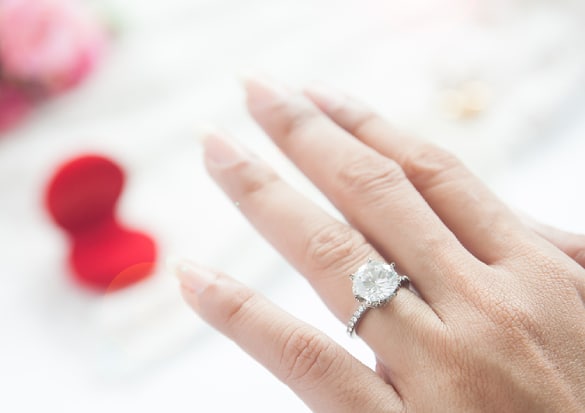Are Lab Grown Diamonds Flawless Compared To Mined Diamonds?
Posted on
As a consumer shopping for a new piece of jewellery, you are definitely spoiled for choice; the plethora of diamonds available in the market are dazzling in every sense of the word. With so many diamond rings for women in every design imaginable, you may be clueless about where to start looking and what kind of diamond you want.
One of your biggest questions would probably be choosing between a mined diamond or a lab grown diamond. You may be puzzled about the various myths surrounding the value and quality of each diamond, so let us dive into the differences between mined and lab grown diamonds and how to pick out one that best suits your needs.

How are mined diamonds formed?
Mined diamonds are formed from carbon atoms that are trapped deep inside the Earth. Beneath the ground, the trapped carbon dioxide is exposed to acute pressure and extremely high temperatures, which then results in a diamond – a process that adds up to more than a billion of years.
With the eco-conscious movement gaining more awareness, chances are you might already know that mined diamonds cause great damage to the environment by worsening soil erosion, depleting natural resources, and increasing energy consumption.
These environmental costs of mined diamonds have resulted in consumers looking for more ethical and eco-friendly alternatives, and lab grown diamonds are one of these increasingly popular options. Nevertheless, some consumers have questioned the label “lab grown” and the quality it offers. This also begs the question, is a lab grown diamond a real diamond?

How are lab grown diamonds formed?
It is a common misconception that lab grown diamonds are not as ‘real’ as mined diamonds are. But the truth is: lab grown diamonds and mined diamonds share the same physical and chemical makeup – and without specialised equipment, there is no way to tell the difference with the naked eye alone. The only difference between a lab grown diamond and mined diamond is their respective origin.
Lab grown diamonds start as tiny carbon seeds placed in machines that produce diamonds after a few weeks. The HPHT diamond machine is one example of such advanced technology – it mimics the natural conditions under which a mined diamond is grown under the Earth’s surface. By exposing the diamond seed to high pressure and high temperature, melted pure carbon forms around the starter seed before it is carefully cooled to form a diamond. This rough diamond is then ready to be cut and polished like a mined diamond.

The 4Cs behind diamond grading
Now you may think that just because lab grown diamonds are formed in the lab, it means they are flawless and have perfect clarity. However, no matter if it is lab grown or mined, not every diamond will come out perfect. Under the mercy of science, each diamond is bound to have imperfections and blemishes in the process of growing. Since neither type of diamond is guaranteed to be flawless, how can you discern the better diamond as a consumer?
Lab grown and mined diamonds actually undergo the same grading process where the gemologists will review them according to a system known as the 4Cs: Cut, Clarity, Colour, and Carat.
Since we’re talking about how flawless a diamond is, we focus on the Clarity factor. The clarity of a diamond depends on the number and depth of inclusions and blemishes in the diamond that affect the overall appearance of the gemstone. The clarity chart consists of 11 specific grades, ranging from Flawless (FL) to Included (I1, I2, I3). No diamond is perfectly pure – but the less visible its inclusions and blemishes are, the better its clarity.
Knowing the clarity of a diamond will help you understand how it contributes to overall quality and price. But even as inclusions and blemishes are expected for both mined and lab grown diamonds, you can get away with a more affordable option for the latter. Lab grown diamonds are generally 20-40% less expensive, which means you have a lot more wiggle room with the 4Cs. Imagine paying the same amount for a lower quality mined diamond to get a lab grown diamond with lesser flaws and inclusions!

Conclusion
As you may have guessed, it is quite impossible for a diamond to have a perfect score when it comes to its clarity. Small imperfections are expected even for lab grown diamonds since they are formed under the turbulent conditions that mined diamonds go through. And since both diamonds are graded the same way, you would be hard-pressed to find a lab grown diamond that cannot match the quality of a mined diamond – all without breaking the bank.
At Star Carat, we are proud to offer some of the most affordable diamond engagement rings in Singapore, made with stunning lab grown diamonds that are IGI-certified. Our lab grown diamonds also belong to the Type IIA category – reserved for the top 2% of the global production of diamonds and considered to be the purest and most valuable of all. Compared to a 1 carat mined diamond, you can expect to enjoy 40% savings on our 1 carat lab grown diamond or get a bigger carat at the same price for more sparkle.
Let us help you find the perfect diamond jewellery for any occasion, be it a sentimental proposal ring as a symbol of your romance or a pair of classic diamond earrings for daily wear. Book an appointment with us today to find out more!
